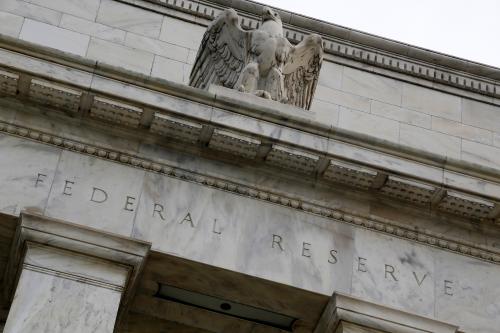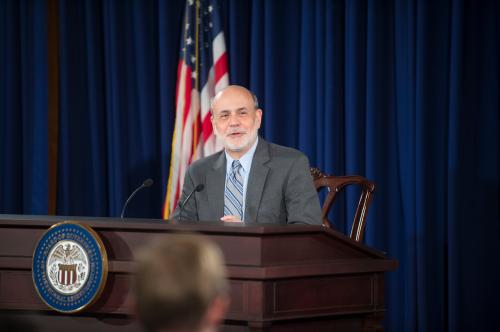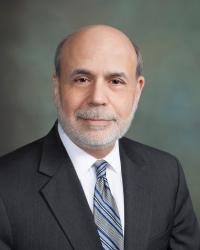Although the U.S. economy appears to be on a positive trajectory, history suggests that at some time in the next few years we may again face a slowdown, with a weakening job market and possibly declining inflation. Given that the historically low level of short-term interest rates is likely to limit the scope for conventional rate cuts, how would the Federal Reserve respond?
As I discussed in my previous post, some tools remain in the monetary toolbox, including taking the short-term interest rate to zero, forward guidance about the future path of short-term rates, more Fed purchases of securities (quantitative easing), and negative short-term rates—a tool used in Europe and Japan but not so far in the US. Collectively, these actions could provide meaningful stimulus to a flagging economy. But what if still more accommodation were needed? In this post and the next I’ll discuss additional options, focusing today on targeting longer-term rates. I conclude that rate targeting can be a useful additional tool for the Fed, complementary to forward guidance and quantitative easing; but, as is the case with other monetary tools, there are ultimately limits to what it can achieve. (For materials from a recent Brookings mini-conference on monetary and fiscal options in the event of a new recession, see here.)
To be clear, I think it is unlikely that exotic policy tools like negative rates or targeting longer-term interest rates will be used in the U.S. in the foreseeable future. So why waste electrons discussing them? One reason is that public beliefs about these tools may influence expectations. For example, if the public and financial market participants are confident that government action will always be capable of returning inflation to the central bank’s target, then long-term inflation expectations are more likely to be “anchored,” which in turn makes attaining the inflation target easier. Consequently, and somewhat paradoxically, educating the public and market participants about more-radical monetary policy alternatives might help ensure that those alternatives are never needed.
Targeting longer-term interest rates
The Fed normally operates by influencing very short-term interest rates. However, we know that targeting rates for securities of longer durations is feasible, under some circumstances, since the Fed did it during World War II and the immediate postwar years. In April 1942, in an effort to reduce the cost of financing the war, the Fed began pegging the interest rate on Treasury bills at 3/8 percent and enforcing a ceiling of 2-1/2 percent on the rate on long-term Treasury debt. The rate on bills was allowed to rise modestly in 1947, but the 2-1/2 percent ceiling on bond yields was maintained for almost a decade, until 1951. [1]
Although the Fed’s pegs of 65 years ago were aimed at minimizing the cost of war finance, the same basic tool could be used today to advance the Fed’s macroeconomic objectives. Even when very short-term interest rates reach zero, longer-term rates (say, those on Treasury securities maturing in two, three, or five years) typically remain meaningfully higher. To ease financial conditions and support a slowing economy, the Fed could consider pegging one or more of these to lower levels. [2] In October 2010, the Fed staff provided the FOMC with a memo analyzing this possibility; I draw from that memo in this post.
To illustrate how a peg could work, suppose that the overnight interest rate were at zero and the two-year Treasury rate were at 2 percent. The Fed could announce that it intends to hold the two-year rate at one percent or less and enforce this ceiling by standing ready to buy any Treasury security maturing up to two years at a price that corresponds to a return of one percent. Since the price of a bond is inversely related to its yield, the Fed would effectively be offering to pay more than the initial market value. Think of it as price support for two-year government debt.
Timing details are important. Suppose the Fed announces on May 1, 2020 that it stands ready to buy any Treasury security that matures on May 1, 2022 or earlier at fixed prices corresponding to a yield of one percent. Note that, as time passes, the May 1, 2022, terminal date would not change (unless explicitly extended); thus, the maturities of the securities the Fed is committed to buy would decline over time, and the program would automatically end on the specified terminal date. Moreover, any securities that the Fed bought under the program would mature by the terminal date, leaving no lasting effect on the Fed’s balance sheet. This “automatic exit” is an attractive aspect of the approach.
Would this strategy be an effective way to lower the two-year interest rate, and, by extension, to reduce still longer-term interest rates (which are influenced by the two-year rate) as well? A lot would depend on the credibility of the Fed’s announcement. If investors do not believe that the Fed will be successful at pushing down the two-year rate, or expect that it might abandon the program before the stated end date (due to inflation concerns, for example), they will immediately sell their securities of two years’ maturity or less to the Fed. In this case the Fed could end up owning most or all of the eligible securities, with uncertain consequences for interest rates overall. On the other hand, if the Fed’s announcement is fully credible, the prices of eligible securities might move immediately to the targeted levels, and the Fed might achieve its objective without acquiring many securities at all.
To achieve credibility, the Fed needs to ensure that any peg it sets is consistent with the likely path of its short-term policy rate. A reasonable strategy would be to combine the announcement of a peg with (consistent) forward guidance about the path of short-term rates. The two announcements would reinforce each other, with the interest-rate target helping to guide market rates toward levels consistent with the forward guidance, and the forward guidance increasing the credibility of the target. [3]
Targeting very long-term interest rates (say, ten years or more) is considerably more difficult than pegging a medium-term rate (two years, say). Suppose for example that the FOMC proposed to target ten-year rates, enforced by an offer to buy securities at fixed prices for two years following the announcement. During the period of purchases, economic information that significantly shifted the path of short-term rates expected over any part of the ten-year horizon could destabilize the peg and lead investors to sell massive amounts of securities to the Fed. For this reason, I expect that the FOMC would not consider trying to target rates on securities of more than two to three years maturity. [4]
Rate-targeting and quantitative easing
A policy of targeting longer-term rates is related to quantitative easing in that both involve buying potentially large quantities of securities. An important difference is that one sets a quantity and the other sets a price. Suppose the government is trying to increase the price of cheese: It could buy a large quantity of cheese and let the market determine the impact of the policy on the price, or it could set a price for cheese and stand ready to buy as much cheese as necessary to enforce that price. Analogously, when using quantitative easing, the central bank buys a stated quantity of securities, but does not directly determine prices and yields. In contrast, a rate-targeting central bank specifies the yield it is trying to achieve (that is, sets a price for securities of a given maturity), but the quantity of securities that it has to buy will depend on the credibility of the peg and other factors.
This comparison is useful for thinking about the benefits and risks of rate-pegging relative to quantitative easing. Rate-pegging would allow the Fed to set rates more precisely and to keep them more stable, which in turn might increase the confidence of households and businesses and make predicting the economic effects of the policy more straightforward. As already noted, a rate peg may also be a useful communication device, e.g., pegging the two-year rate at a low level would strongly signal the central bank’s intention to keep short-term rates low for some time as well. The primary risk of rate-pegging is that the Fed might end up buying very large amounts of securities; in the extreme, it could end up buying the entire stock of securities of a given maturity, without fully achieving its rate target. (In contrast, in a quantitative easing program, the amount to be purchased is typically specified in advance.) Concerns about “losing control of the balance sheet” were a factor behind the Fed’s choice of quantitative easing over rate targets while I was chairman.
Rate-targeting differs from quantitative easing in its channels of effect and in its impact on interest rates at different maturities. With quantitative easing, the Fed tried to reduce yields on securities of longer maturities by buying mostly longer-term bonds. QE works most directly by reducing the risk and liquidity premiums on securities, although it also influences expectations about how short-term rates will evolve. For reasons described earlier, rate pegs are likely to be focused on medium maturities, and they work in large part by signaling the path of short-term rates that the Fed expects. Conceivably, QE and rate-pegging could be used together to reduce longer-term rates, with QE working through reduced risk premiums while the rate peg operates indirectly by affecting the expected path of short-term interest rates. Both tools could be complemented by effective forward guidance which provides information on the Fed’s plans for short-term rates.
Conclusion on targeting longer-term rates
Targeting longer-term interest rates could be a useful additional tool for the Fed when short-term rates are zero. The announcement of a rate peg could have powerful signaling effects, thereby reducing longer-term rates without necessarily forcing a significant expansion of the Fed’s balance sheet. Rate pegs could also be useful complements to other unconventional policies, such as forward guidance or quantitative easing. The principal limitations of rate pegs are similar to those of forward guidance: Both tools are relatively less effective at affecting interest rates at longer maturities, and even at shorter horizons both must be consistent with a credible or “time-consistent policy” path for short-term interest rates. That is, for a rate peg to work, market participants must be confident that the FOMC will keep short-term interest rates on a path consistent with the target for the longer-term rate.
[1] After the war, with a large national debt outstanding and with a new war brewing in Korea, the Truman Administration, particularly the Treasury, put considerable pressure on the Fed to continue the interest-rate pegs. However, with wartime price controls and rationing phased out, Fed policymakers became increasingly concerned about the inflationary implications of persistently low interest rates, and they pushed back against the Treasury’s demands. Ultimately, after contentious debate, in March 1951 the Fed and Treasury signed a formal Accord that freed the Fed from its commitment to peg rates.
[2] I discussed the pegging option in a 2002 speech while a Federal Reserve Board member.↩
[3] The 2010 Fed memo discussed a clever approach for increasing the credibility of both the rate peg and the associated forward guidance, which is for the Fed to sell put options to market participants. These options would give holders the right to sell eligible securities to the Fed at the specified prices at any time over the initially stated horizon (two years, in the example). With these options, securities holders would be legally protected even if the Fed abandoned the program, eliminating their need to sell their holdings to the Fed pre-emptively. Moreover, with option sales, the Fed might be less likely to abandon the peg in the first place, since doing so would lead the Fed to take losses as investors cashed in their put options. Unfortunately, although the idea of selling options is intriguing, there are questions about both the appropriateness of the action and the Fed’s legal authority in the area.↩
[4] So how did the pre-1951 Fed succeed in capping the rates on very long-term bonds? It’s a bit of a puzzle. Probably wartime controls and limited liquidity in the bond markets helped. It may also be that, for most of the rate-targeting period, investors were comfortable that inflation and short-term would stay low indefinitely and thus had no reason to challenge the peg (see Eichengreen and Garber). By late 1947, with inflation rising and wartime controls eliminated, the peg was coming under pressure, and the Fed had to buy a significant quantity of long-term securities to keep the peg in place (Eichengreen-Garber, p. 182). ↩
Comments are now closed for this post.










Commentary
What tools does the Fed have left? Part 2: Targeting longer-term interest rates
March 24, 2016